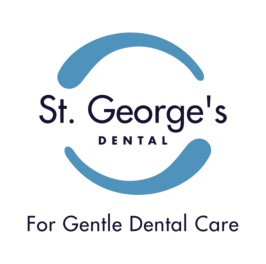© St. George’s Dental Practice 2022
St. George’s Dental Practice
9 Upper Bridge St.
Canterbury
Kent
CT1 2NA
Call us on 01227 450300
Email: stgeorgesdp@yahoo.co.uk
Opening Hours
Monday 9am to 6pm
Tuesday 9am to 6pm
Wednesday 9am to 6pm
Thursday 9am to 6pm
Friday 9am to 6pm
Saturday Closed



Gum Disease
Gum disease is either Gingivitis or Periodontitis.
Gingivitis is inflammation of the gum around the tooth but does not involve any loss of the bone or periodontal
ligament.
It can usually be resolved by improving oral hygiene. This can be done by being more thorough when doing tooth
brushing and by brushing more often (Brushing gently though!). Flossing between the teeth is also helpful. A simple
scaling of the teeth carried out by a dentist or hygienist will also help.
Periodontitis is a more serious problem. It is defined by loss of attachment of the periodontal ligament to the tooth and
subsequent loss of the bone support around the tooth. If allowed to progress it can lead to loss of teeth as they can
become loose. Periodontal disease can be quite insidious and progress over a number of years and may not be noticed
by the patient until a tooth becomes sensitive or loose. During a routine examination the dentist checks the teeth and
gums for evidence of gum disease. This is done by probing around the teeth to check for pockets between the gum and
tooth, also to check for bleeding on probing the gum and we also check to see if any teeth are getting a bit loose. Quite
often xrays are taken to check the bone levels around the teeth.
Once gum disease is identified by the dentist a treatment plan is discussed and agreed with the patient.
Gum disease is caused by plaque which usually appears as a whitish sticky layer on the teeth and it is colonised by
bacteria. The bacteria cause the gum disease. Calculus(Tartar) deposits which build up on the teeth can make it harder
to remove plaque.
Treatment involves improving the patient’s home cleaning regime. A superficial cleaning is carried out which will remove
plaque and calculus(tartar) deposits visible above the gum. Further visits may be needed to carry out cleaning of root
surfaces. This will usually be done under local anaesthetic.
In some very severe cases of periodontal disease a referral to a Peridontist (a specialist in gum disease) may be advised
and this would be discussed with the patient.
Some patients are more susceptible to gum disease than others. It cannot be reversed but it can be controlled with
dedicated daily care.
Gum Disease


© St. George’s Dental Practice 2024
Call us now on
01227 450300

© St. George’s Dental Practice 2024

Gum Disease
Gum disease is either Gingivitis or
Periodontitis.
Gingivitis is inflammation of the gum around
the tooth but does not involve any loss of
the bone or periodontal ligament.
It can usually be resolved by improving oral
hygiene. This can be done by being more
thorough when doing tooth brushing and by
brushing more often (Brushing gently
though!). Flossing between the teeth is also
helpful. A simple scaling of the teeth carried
out by a dentist or hygienist will also help.
Periodontitis is a more serious problem. It is
defined by loss of attachment of the
periodontal ligament to the tooth and
subsequent loss of the bone support around
the tooth. If allowed to progress it can lead
to loss of teeth as they can become loose.
Periodontal disease can be quite insidious
and progress over a number of years and
may not be noticed by the patient until a
tooth becomes sensitive or loose. During a
routine examination the dentist checks the
teeth and gums for evidence of gum disease.
This is done by probing around the teeth to
check for pockets between the gum and
tooth, also to check for bleeding on probing
the gum and we also check to see if any
teeth are getting a bit loose. Quite often
xrays are taken to check the bone levels
around the teeth.
Once gum disease is identified by the dentist
a treatment plan is discussed and agreed
with the patient.
Gum disease is caused by plaque which
usually appears as a whitish sticky layer on
the teeth and it is colonised by bacteria. The
bacteria cause the gum disease.
Calculus(Tartar) deposits which build up on
the teeth can make it harder to remove
plaque.
Treatment involves improving the patient’s
home cleaning regime. A superficial cleaning
is carried out which will remove plaque and
calculus(tartar) deposits visible above the
gum. Further visits may be needed to carry
out cleaning of root surfaces. This will usually
be done under local anaesthetic.
In some very severe cases of periodontal
disease a referral to a Peridontist (a
specialist in gum disease) may be advised
and this would be discussed with the
patient.
Some patients are more susceptible to gum
disease than others. It cannot be reversed
but it can be controlled with dedicated daily
care.















